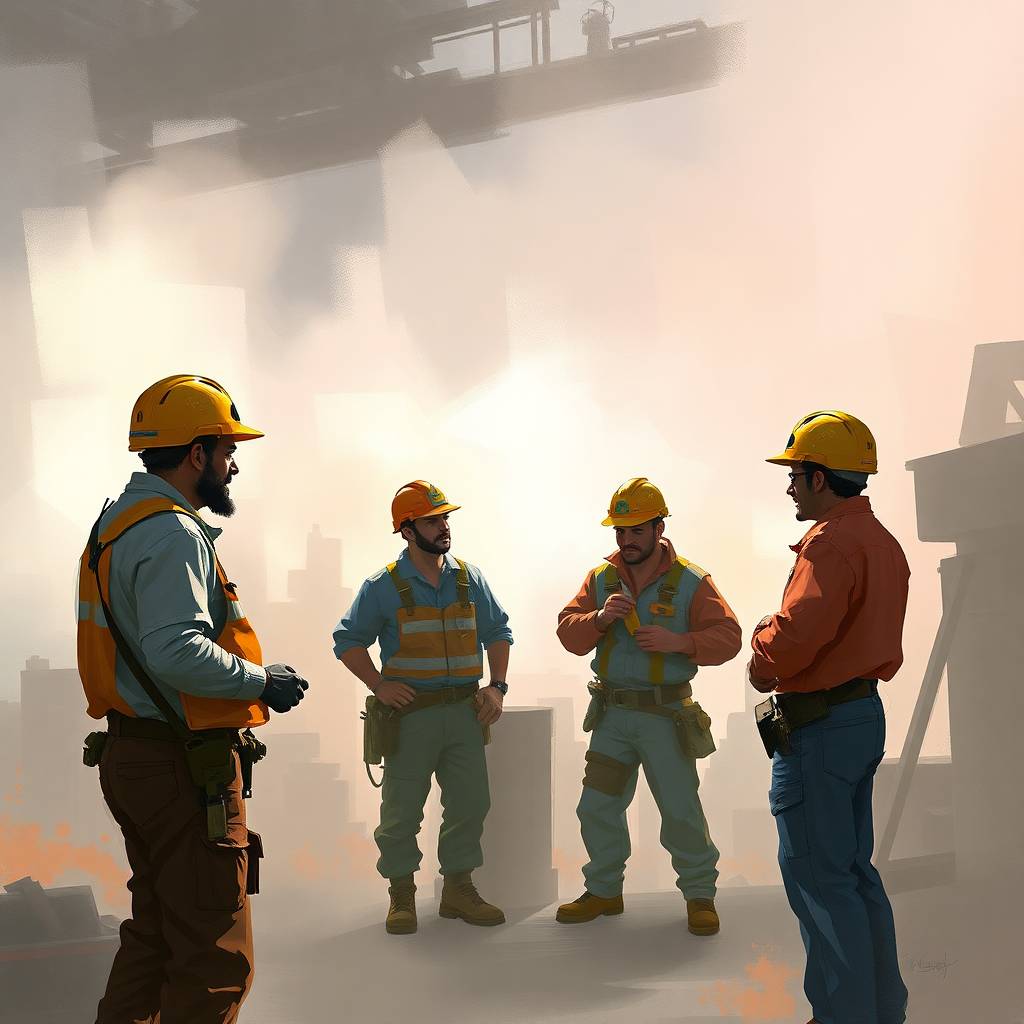Toolbox talks are short, focused safety discussions held before a shift or specific high-risk task. They’re one of the most effective ways to raise awareness, reduce risk, and ensure compliance with WHS legislation on Australian worksites.
This guide shares toolbox talk topics organised by hazard or activity type. Each section includes key talking points, safety tips, and links to full guides you can use to prepare and deliver effective toolbox meetings. Use this page to improve safety culture, reduce incidents, and stay WHS compliant.

Why Toolbox Talk Topics are Important
Toolbox talks are essential because:
- They bridge the gap between policy and practice.
- They refresh safety knowledge without requiring formal training sessions.
- They help workers identify and control risks before starting a job.
- They foster a culture of communication, consultation, and continuous improvement.
In high-risk industries, most serious injuries happen when basic safety protocols are ignored. Toolbox talks tackle this head-on by keeping risks top of mind.
Key Safety Points to Cover in a Toolbox Talk
A toolbox talk doesn’t need to be long, 5 to 15 minutes is ideal, but it should be focused and practical. Your topic should relate directly to the day’s work or a specific hazard.
Some key elements to include:
- A real-life incident or example (if applicable)
- A brief description of the hazard or task
- The risks associated with it
- The required control measures (use the hierarchy of control)
- PPE requirements
- Any permits or procedures in place
- Key responsibilities of the team
Here’s an example outline:
“Today we’re working at heights. That means we need to wear harnesses, check our anchorage points, and make sure edge protection is in place. Falls over 2 metres require a SWMS, and you must be trained to use fall arrest systems. Let’s walk through the pre-start checklist now.”
Toolbox Talk Questions & Discussion Prompts
Toolbox talks work best when they’re interactive. Ask your team questions such as:
- What are the top three risks in today’s task?
- Has anyone had a near-miss doing this before?
- What could go wrong if we skip a step?
- What PPE is required for this job?
- What’s our emergency procedure for this hazard?
Open-ended questions encourage your team to think critically and speak up — turning a lecture into a discussion.
How to Run a Toolbox Talk That Works
Here are a few tips to make your toolbox talks effective:
- Choose a relevant topic
Base it on the task at hand, recent incidents, seasonal hazards, or lessons learned. - Keep it short and focused
5–15 minutes is the sweet spot. Long talks lose attention. - Use real examples
Stories and incidents make it more memorable than reading off a policy. - Encourage discussion
Ask open-ended questions, get input from the team, and listen. - Document it
Record the topic, attendees, and discussion summary for compliance. - Repeat regularly
Daily on high-risk sites. Weekly or fortnightly elsewhere.
Toolbox Talk Topics Index
- Working at Heights
- Welding Safety
- Workplace Housekeeping
- Safety Culture
- Plant and Machinery
- Safety Signs and Symbols
- Office Ergonomics
- Hierarchy of Control
- Landscaping
- Plumbing Safety
Working at Heights Toolbox Talk
Falls from height are a leading cause of injury and death in Australian workplaces. This toolbox talk highlights common risks when working at height, including ladder use, scaffolding, harnesses, and roof work. It also covers key controls such as guardrails, exclusion zones, and mandatory SWMS requirements.
Why This Topic Matters
Falls from height remain one of the leading causes of workplace fatalities in Australia. Even low-level falls can result in serious injuries.
Key Safety Points to Cover
- Correct use of ladders and scaffolding
- Fall arrest systems and harnesses
- Guardrails and edge protection
- SWMS requirements
- Site-specific fall hazards
Toolbox Talk Questions & Discussion Prompts
- When is a harness required on this site?
- What fall hazards do we have today?
- Who is trained in working at height rescue?
Read the full toolbox talk: Working at Heights
Welding Toolbox Talk
Welding poses multiple risks including eye damage, burns, fire, and toxic fumes. This talk focuses on PPE like welding shields and gloves, ventilation and fume extraction, hot work permits, and fire safety readiness. It’s ideal for fabrication sites, workshops, and construction settings.
Why This Topic Matters
Welding exposes workers to arc flashes, toxic fumes, fire hazards, and burns — even in small-scale work.
Key Safety Points to Cover
- Use of welding shields and gloves
- Ventilation and fume extraction
- Fire watch protocols and extinguishers
- Electrical safety and grounding
- PPE requirements
Toolbox Talk Questions & Discussion Prompts
- Where’s the nearest fire extinguisher?
- Are hot work permits required today?
- How are fumes being ventilated?
WHS Legal Context
Hot work must follow AS/NZS 1674.1 and WHS Code of Practice for Welding Processes.
Read the full toolbox talk: Welding Safety
Workplace Housekeeping Toolbox Talk
Good housekeeping reduces trip hazards, prevents accidents, and creates a more productive worksite. This session covers clutter control, spill management, storage practices, and proper waste handling. Simple changes can prevent serious injuries.
Why This Topic Matters
Cluttered or messy worksites cause slips, trips, and reduced productivity. Simple changes prevent serious accidents.
Key Safety Points to Cover
- Clear walkways and remove trip hazards
- Clean spills immediately
- Proper storage of tools and materials
- Waste management and disposal
Toolbox Talk Questions & Discussion Prompts
- Who’s responsible for clean-up today?
- Are storage areas organised?
- What are our top trip hazards?
WHS Legal Context
Falls on the same level account for thousands of injuries and are covered under general duties of care.
Read the full toolbox talk: Housekeeping
Safety Culture Toolbox Talk
A strong safety culture starts with open communication, visible leadership, and personal accountability. This talk encourages workers to speak up, report hazards, follow procedures, and support one another in maintaining a safe environment.

Read the full toolbox talk: Safety Culture
Plant and Machinery Toolbox Talk
Operating plant and machinery carries major risks, especially in high-traffic or confined areas. Discuss pre-start checks, communication protocols, exclusion zones, blind spots, and lockout/tagout procedures. Great for teams using excavators, forklifts, or mobile equipment.
Read the full toolbox talk: Plant and Machinery
Safety Signs and Symbols Toolbox Talk
Safety signs guide behaviour and communicate critical hazards. This talk breaks down the meanings behind colour codes, mandatory signs, prohibition signs, warning symbols, and emergency signage. Reinforce the importance of recognising and following signage on site.
Read the full toolbox talk: Safety Signs
Office Ergonomics Toolbox Talk
Poor ergonomics can lead to chronic pain, fatigue, and lost productivity. Cover monitor height, desk posture, breaks, lifting technique, and basic stretches. Ideal for offices, admin areas, and remote workers.
Another solid point can be around a workplace stress toolbox talk.
Read the full toolbox talk: Office Ergonomics
Hierarchy of Control Toolbox Talk
The hierarchy of control is a fundamental concept in WHS risk management. This talk explains the five levels of control (elimination, substitution, engineering, administrative, and PPE) and how to apply them to real-world situations to reduce risk effectively.

Read the full toolbox talk: Hierarchy of Control
Landscaping Toolbox Talk
Landscaping workers face risks from manual handling, powered tools, uneven terrain, and weather exposure. This session covers tool safety, PPE use, environmental awareness, and equipment checks to keep grounds maintenance staff safe.
Read the full toolbox talk: Landscaping
Plumbing Toolbox Talk
Plumbing involves hazards such as confined spaces, pressurised systems, electrical exposure, and hazardous substances. This talk covers job planning, isolating services, PPE requirements, and emergency procedures.
Read the full toolbox talk: Plumbing
Free Toolbox Talk Templates
Need ready-to-use templates? We offer printable PDF toolbox talk handouts for each topic to help you save time and run effective meetings. You’ll find them available for download on each individual toolbox talk article, or get in touch to access our complete WHS toolbox talk library.
FAQs
Are toolbox talks required by law in Australia?
Not specifically, but the WHS Act requires training, consultation, and communication, all of which are supported by toolbox talks.
Who should lead a toolbox talk?
Usually the site supervisor, safety officer, or team leader. Anyone with WHS awareness and leadership responsibility.
How often should toolbox talks be done?
It depends on the risk level of the work. High-risk industries often do daily talks. Others may do them weekly or fortnightly.
Do toolbox talks need to be recorded?
Yes. You should keep a record of each talk for your WHS system, including who attended and what was discussed.
Can toolbox talks be reused?
Yes, but update them with new examples and keep them relevant. Rotating topics helps keep engagement high.
Want Ready-to-Use Toolbox Talks?
We’ve created practical toolbox talk guides for dozens of WHS topics. You can view each one on our blog and download free printable templates to use on-site.
If you’d like access to the full set of toolbox talks in one pack, get one for your industry.


